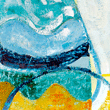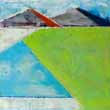patricia clark-finley
 Patricia Clark-Finley pictured in her studio on Orcas Island, marveling at the perfect solitude. She says: "When you have to make the art or you will just explode -that is the time to start. The beauty of artists I enjoy is the lyrical gesture which is elegant - without preciosity or pretension."
Patricia Clark-Finley pictured in her studio on Orcas Island, marveling at the perfect solitude. She says: "When you have to make the art or you will just explode -that is the time to start. The beauty of artists I enjoy is the lyrical gesture which is elegant - without preciosity or pretension."
Patricia Clark-Finley studied at the UW and UC Berkeley and completed a BFA at the San Francisco Art Institute. She has also spent time at the San Francisco Center for the Book, Carl Jung Institute, and Crown Point Press. Her work has been included in Bay Area Exhibitions juried by artists such as Viola Frey, Carlos Villa, and Christopher Brown. She launched her first solo exhibition in San Francisco, in 1991, and was included in the San Francisco Museum of Modern Art Gallery at Fort Mason. Her work has been included in numerous galleries and invitational exhibitions.
She creates the labels and brand identity for Mount Baker Vineyards, the winery she and her husband, Randy Finley, have brought from a cozy spot in the country to a well-established player in the Northwest wine industry.
"My art process reflects the family cultures I come from. At the foreground are issues of migration, movement, and constant change. My own nomadic wandering is both intellectual and also physical as my studio location and my reading list seems to change every few years. The birds that populate my images seem to echo this freedom of wandering. Most recently, the broad expanse of abstraction and light are inspired by the weather watching I do from my studio windows."
The artist shows her latest work in abstraction that offers an intuitive analysis of gradients - extracted, inverted, and turned inside out. Light overlays the substance of matter.
In an artist statement: "Trees and rocks have a job. They are supposed to be trees and rocks. So that job is taken. As an artist, I also have a job - to interpret, to examine, and place in the context of contemporary culture - to assemble - to create art that the viewer can come back to and go away from and find something human there.
Particularly this overlays in the art just as the tide rises and falls, the wind ruffles, storm surges, seals and whales breech and submerge, recording the tickles and whispers along this skin of the oceans. My work interprets a shimmer of rustling breezes. of rocky shores and craggy islands that support their forests in shifting patterns of shadow and light. Objects drop away, leaving optic remnants of transparency, light and color."
"Encaustic first piqued my interest when I saw a show of Jasper John's at the San Francisco Museum of Modern Art. I found it had a cultural history going back to Egyptian tombs and possessed the organic qualities of beeswax. With encaustic, I might achieve the textural depth and complexity I enjoy in abstract expressionism, with the incised precision of dry point line from etching. I find the jewel-like colors of encaustic too seductive to resist, so I just go with that. I use the most intense pigments I can find and mix that with resin and natural beeswax. As I have investigated various substrates, linen stretched over board has emerged as the most efficient surface to work on, and it has an interesting texture beneath the wax."
"Encaustic is not damaged by light. It is very stable. It can also be buffed with a soft cloth, so cleaning is not an issue. The resin raises the melting temperature of the wax, but you wouldn't want to test the theory by leaving it in a hot car. But then you wouldn't leave any fine art in harm's way.
In a previous fairweather house & gallery show, Patricia Clark- Finley showed encaustic pelicans, swans, crows and gulls. Just a few of the birds we all have the luxury of watching from our perches along the ocean shore."
In addition to original artworks, for the 2013 summer show, the artist is producing prints which is going to last a long time and have the texture and luminosity of fine art. The editions are limited by the fact that the artist produces each print, a hybrid that is expensive for the artist in the beginning, but more economical for the casual art collector in the long run. She signs each print. She has done a lot of printmaking and has great admiration and fascination for archaic printing methods and the rhythm and focus of printmaking. She has spent time at Crown Point Press and the San Francisco Center for the Book, and the San Francisco Art Institute. She has sold etchings, monotypes, and mixed media pieces.














